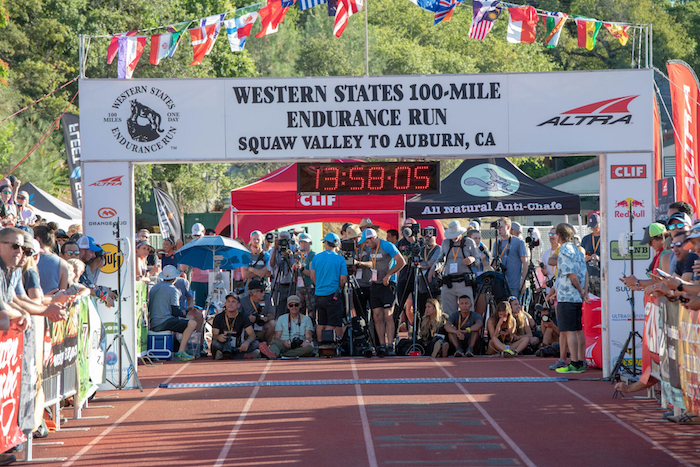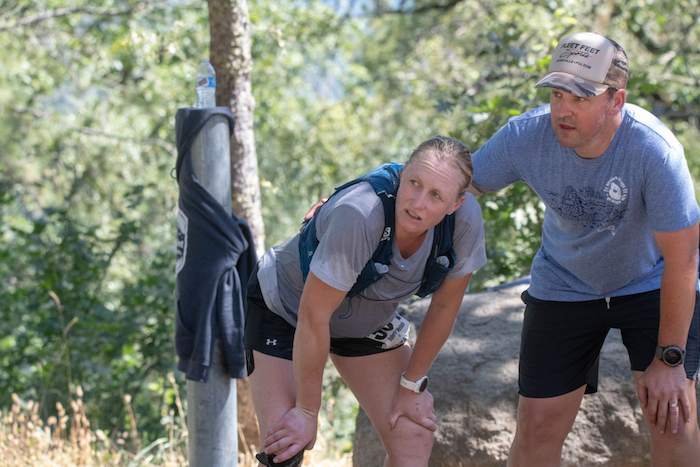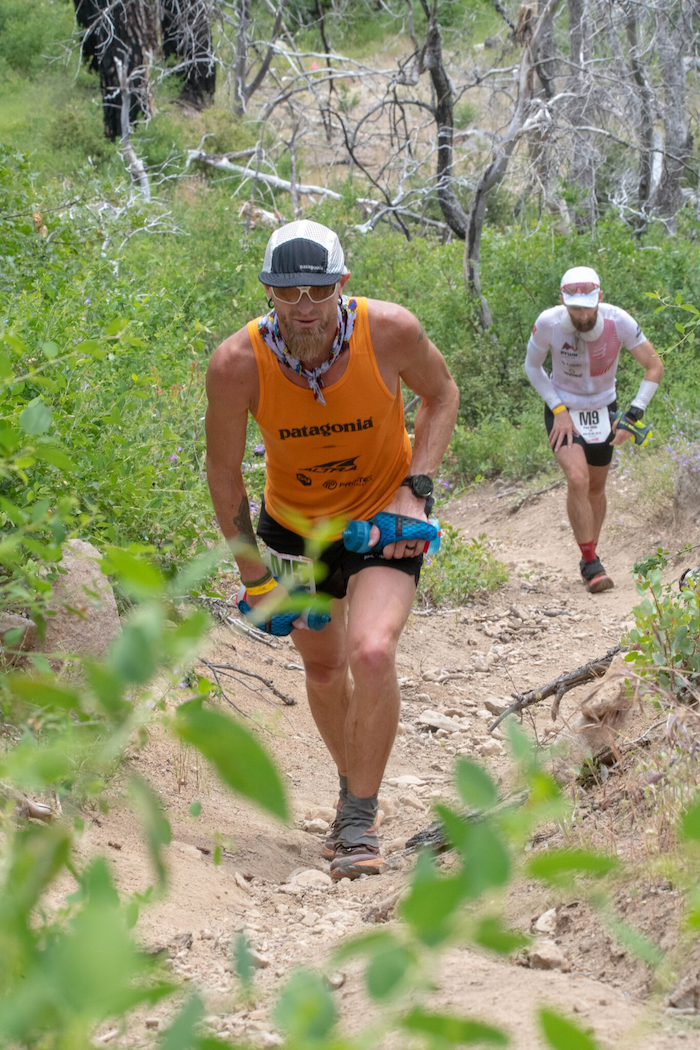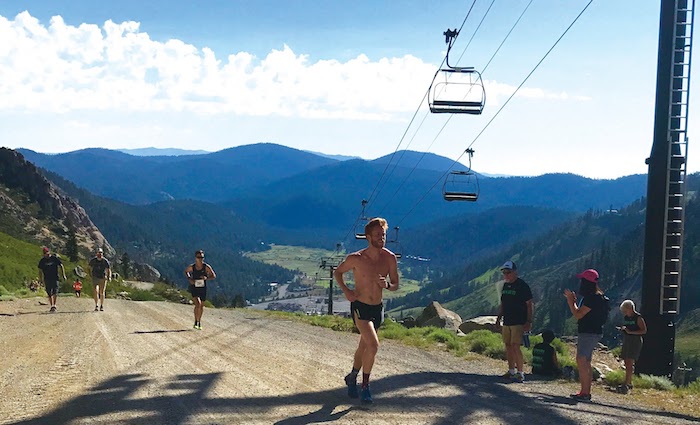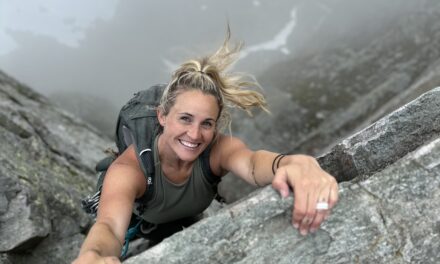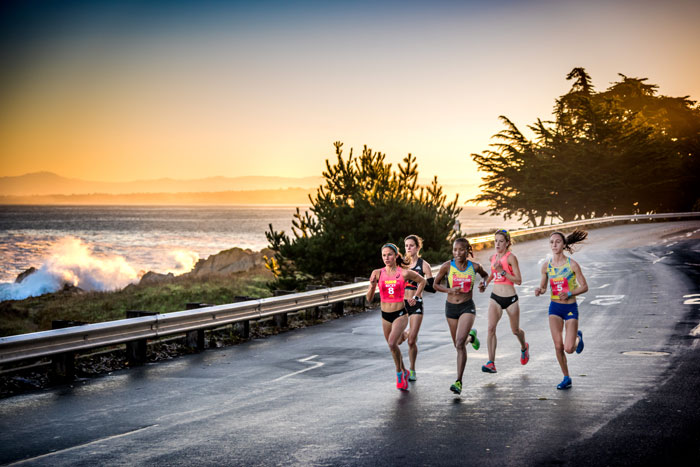- Exploring Lava Beds National Monument - 07/15/2024
- Wandering Through Washington - 03/21/2024
- Striding Through Socal Sun, Storms and Snow - 12/27/2023
Challenge and camaraderie
Words by Matt Johanson
Photos by Luis Escobar
One hundred miles of murderous terrain stretches out the field of Western States Endurance Run, but the legendary race still sees an occasional photo finish. Those in Placer High School’s LeFebvre Stadium in the late hours of June 29 witnessed a sprint for the ages.
After more than 18 hours of racing up and down Sierra Nevada mountains, top competitors Camelia Mayfield and Kaytlyn Gerbin raced the final quarter mile neck and neck. The pair electrified the midnight crowd with dueling kicks down the homestretch. As cowbells clanged and fans screamed, Mayfield edged Gerbin by a fraction of a second.
Then the two exhausted rivals joined the joyful post-race celebration that delights as much as the race demands, as euphoric athletes embrace family, their crew members and each other.
At Western States, challenge and camaraderie go hand in hand, and both in mountain range-sized quantities.
“At the start of the race I found myself surrounded by a bunch of badass women,” recalled Gerbin, 30. “We were chatting about how strong the women’s field was this year, and someone joked about it ‘coming down to a sprint on the track.’ I laughed and said ‘There is absolutely no way I want to sprint on a track against any of you ladies!’ One hundred miles and many mountains later, there I was, leaving every ounce of energy out on that track in a 200 meter sprint over fifth or sixth place. What a race!”
Western States starts at Squaw Valley each June, climbs 15,540 feet and drops 22,970 feet on the way to Auburn. Nearly all of the race takes place on trails in Granite Chief Wilderness and Tahoe National Forest, often miles from the nearest town or road. The grueling event began in 1974 and has grown into the most prestigious 100-mile trail race in the world. In 2019, 5,862 runners from more than 25 countries applied to compete. A lottery each December determines just 369 entries.
“They say there are three types of runners at Western States: the survivors, the runners and the racers,” professed three-time champion Jim King.
Taking those groups in reverse order, let’s start with the “racers,” and there’s never been another one like two-time champion Jim Walmsley. The 29-year-old triumphed in the men’s division in 14 hours, 9 minutes and 28 seconds, destroying his own course record by more than 20 minutes. Jared Hazen, Walmsley’s training partner and best friend, finished second in 14:26.46, also beating the previous course record. Tom Evans took third in 14:59.44 as the three men beat 15 hours together for the first time in the race’s history.
“There is such an overflowing satisfaction that comes from going to the well and knowing you gave everything,” shared Walmsley, who skipped and danced through the finish line in ecstasy. “Thank you to everyone for your overwhelming support and good vibes.”
Clare Gallagher won the women’s division in 17:23.25, fighting off a fierce challenge by runner up Brittany Peterson, who clocked 17:34.29. Kaci Lickteig took third in 17:55.55.
Gallagher, 27, had just returned from a two-week Arctic climbing expedition and shocked herself with her victory. “Never in my wildest dreams while traipsing through tundra just weeks ago did I think this would happen,” she reflected. “Then the race between Brittany and me happened and my feral instincts kicked in. Those last six miles were the most intense miles of my life!”
If King’s “racers” are the elite competitors, those he described as “runners” would be those fighting for sub-24 hour finishes. This year 130 broke the one-day barrier, earning coveted silver belt buckles for their performances.
Among them was Addie Bracy, who raced to a 19:53.38 finish and credited not just her crew but also race organizers and volunteers.
“Being the runner is the easy job when it comes to just how much goes into these races,” claimed Bracy, 32. “It makes me tear up to think about my crew out there doing everything possible for me to be successful, all the race organizers who put such a huge event on, and the hundreds of volunteers out on the course, just to help others achieve their dream. If that doesn’t tell you just how special ultra running is then I don’t know what will.”
King’s “survivors” would be the majority of participants who finish between 24 and 30 hours, when the race officially concludes. Earning bronze belt buckles in 2019 were 189 such fighters, including Chris Sipe, who overcame a fall and injury to finish in 28:07.40.
“I wanted to quit at Michigan Bluff (mile 55),” admitted Sipe, 38. “I had fallen 4.5 miles into the day when I slipped on icy snow. My quad slammed into the ground causing pain and spasms the rest of the race. Gordy Ainsleigh (the first person to run Western States) pulled me aside and gave me a back adjustment and basically told me to get back out there. I’m glad I did. I still finished over an hour faster than last year.”
Completing this race at all marks the pinnacle of many runners’ careers and their abundant joy is heartwarming to see. Those who visit the finish area quickly learn why stadium announcer John Medinger described it as “the happiest place on Earth.”
Yet spare a moment to recognize those whose considerable efforts fell short. Fifty runners, or 14 percent of the field, did not complete the race in 2019. That figure has exceeded 50 percent in other years. Even though these competitors’ races ended in disappointment, their stories can still inspire.
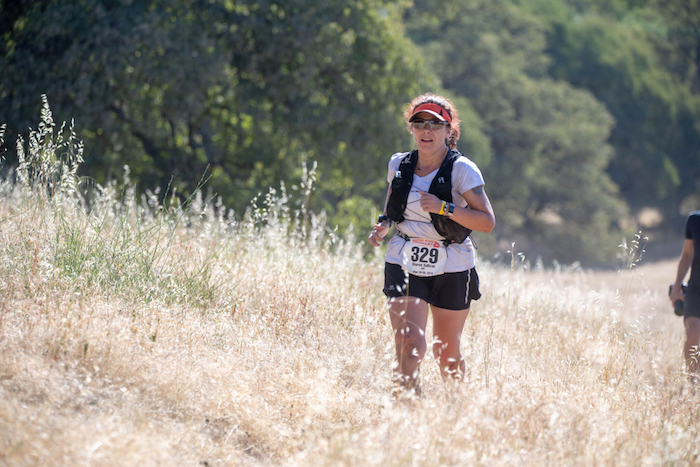
Sharron Sullivan of Great Britain (#329) was one of 80 international runners, nearly a quarter of the field.
Kyle Robidoux, 43, attempted to become the first blind runner to complete the race. He fell more than a dozen times in the snow and had to drop out, but then cheered on his competitors for five hours. Defending champion Courtney Dauwalter, 34, led the women’s division at record pace until a hip injury struck at mile 66. She fought for 13 more miles before it forced her to stop, but graciously congratulated Gallagher, the new champion.
And Dave Mackey, 49, nearly finished the run on a prosthetic leg. A runner up from 2004, Mackey suffered an accident in 2015 when a boulder crushed his lower left leg, requiring multiple surgeries and eventually amputation. He still completed 93 miles of the course. “I left it all out there and I’m super proud of my effort,” he declared.
Western States seems to showcase such positive-thinking people who express sportsmanship and find silver linings despite events others would regard as soul-crushing setbacks.
“Every Western States is full of stories, emotions, hope, heartbreak and redemption. Many had their day, and many didn’t. Such is the nature of the Western States 100. It is a monster of a course,” reflected ultra runner Nick Errol, a 2017 competitor. “This race provides the greatest point to reflect, grow, learn and an opportunity to come back and get it right. Such is the beauty of ultra-running that heartbreak can turn into a powerful point of redemption over time.”

